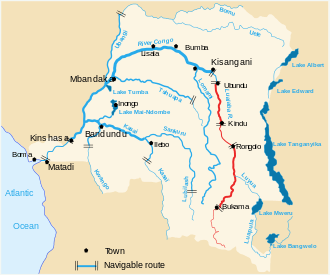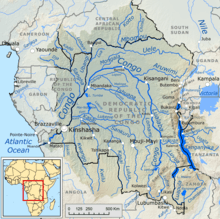Lake Chad replenishment project
The Lake Chad replenishment project is a proposed major water diversion scheme that would involve damming the Ubangi River at Palambo in Central African Republic and channeling some of the water to Lake Chad through a navigable canal.[1]

The canal was proposed by Italian firm Bonifica[2], and would generate hydro-electricity at several points along its length. These would power new industrial townships, while the canal would replenish the lake.[3] The irrigation scheme for a 2,400 km canal from the Congo Basin to the lake, which has been steadily shrinking, was considered unlikely to materialize as late as 2005.[4]
The members of the Lake Chad Basin International Commission are Chad, the Central African Republic, Nigeria, Cameroon and Niger. Concerned by shrinkage of the lake's area from 20,000 square kilometres (7,700 sq mi) in 1972 to 2,000 square kilometres (770 sq mi) in 2002, they met in January 2002 to discuss the project. Both the ADB and the Islamic Development Bank expressed interest in the project. However, the member states of the Congo-Ubangi-Sangha Basin International Commission, Congo-Kinshasa, Congo-Brazzaville and the Central African Republic expressed concern that the project would reduce the energy potential of the Inga hydroelectric dam, would affect navigation on the Ubangi and Congo rivers and would reduce fish catches on these rivers.[5]
Alternative inland waterway


An inland waterway from Ubangi River to Chari River), around 366 km channel, from Gigi river (close to Djoukou - Galabadja in Kémo), through Sibut, Bouca and then to Batangafo (over Boubou river and into Ouham River and then Chari river).
This path is the used by the CIMA (Canada) study (water flow 100m3/s) made in contract of the Lake Chad Basin Commission (same water flow as the Moscow Canal), only sizing the channel and adapting the river and lock (water navigation).
Chad-Congo inland waterway
This waterway can link the lake Chad with the Congo River inland navigation system and the waterway transport in the Democratic Republic of the Congo.
The navigable waterway system in Congo can be upgraded from Kinshasa to Matadi sea port, already planned as an option in the Inga dams project.
As well as it is "feasible" from Lake Mweru (Pweto city) through Luvua River to Ankoro (requiring dams and Boat lift in Boyoma Falls,... as the Three Gorges dam ship lift), or the waterway into the Lake Tanganyika in Kalemie through the Lukuga River up to Kabalo (Zanza village), now link by railway.
Other World main channels
A channel Ubangi-Chari is double the distance of the Rhine–Main–Danube Canal, but half the distance of the Saint Lawrence Seaway that link the Great Lakes Waterway (waterway from New Orleans to Quebec), three times the Moscow Canal (100-130m3/s) or Volga–Don Canal, a third of the Volga–Baltic Waterway (that form the Unified Deep Water System of European Russia), and 5 times shorter than the 1974 Km Grand Canal (China) (build in the Sui dynasty).
References
- Abiodun Alao (2007). Natural resources and conflict in Africa: the tragedy of endowment. University Rochester Press. p. 323k. ISBN 1-58046-267-7.
- Ross, Will (2018-03-31). "Can the vanishing lake be saved?". Retrieved 2019-01-28.
- Graham Chapman, Kathleen M. Baker (1992). The Changing geography of Africa and the Middle East. Routledge. p. 56. ISBN 0-415-05710-8.
- Michele L. Thieme (2005). Freshwater ecoregions of Africa and Madagascar: a conservation assessment. Island Press. p. 195. ISBN 1-55963-365-4.
- Europa Publications Limited (2002). Africa South of the Sahara 2003. Routledge. p. 266. ISBN 1-85743-131-6.
External links
- Web of the Water transfer project, Study of CIMA International (Canada) under contract from Lake Chad Basin Commission. Same path as the proposed waterway, adapting it for inland navigation.